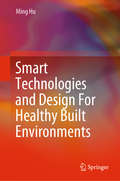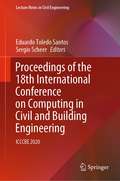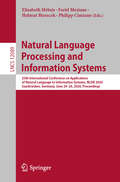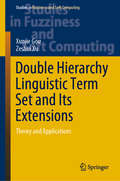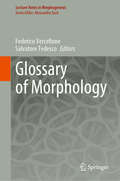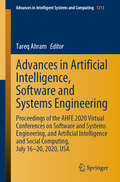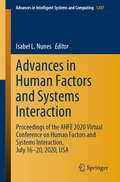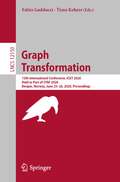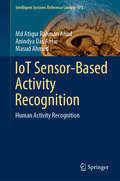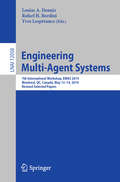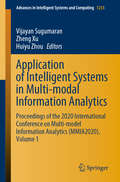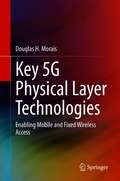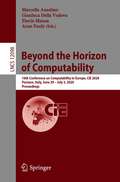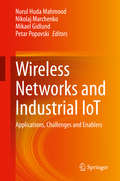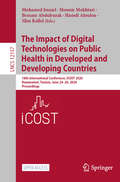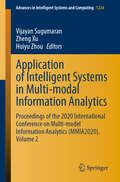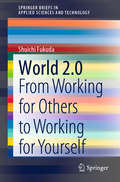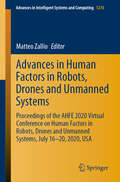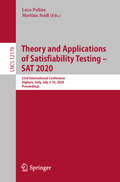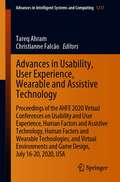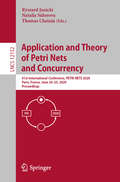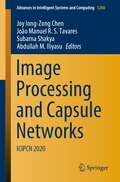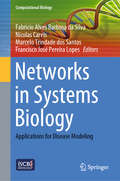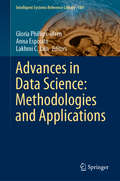- Table View
- List View
Smart Technologies and Design For Healthy Built Environments (Springerbriefs In Applied Sciences And Technology Ser.)
by Ming HuSmart Technologies and Design for Healthy Built Environment connects smart technology to a healthy built environmentthat builds upon the sustainable building movement.It provides an overall summary of the state-of-the-art technologies that are applied in the built environment. The book covers a broad spectrum of smart technology categories ranging from dynamic operability, energy efficiency, self-regulating and self-learning systems, and responsive systems. The foreseeable challenges that are associated with smart technologies are discussed and outlined in the book. Firstly, this book provides a snapshot of state-of-the-art smart technologies being applied in the built environment. It covers a broad spectrum of smart technology categories, ranging from dynamic operability, energy efficiency, self-regulating and self-learning systems, to responsive systems. Secondly, this book provides in-depth analysis of the four primary components of health (biological, physical, physiological and psychological); their effects on wellbeing and cognitive performance are introduced as well. Thirdly, it connects smart technologies to those health-influencing factors by reviewing three completed smart building projects. This book can also serve as a basis for education and discussion among professionals and students of diverse backgrounds who are interested in smart technologies, smart building, and healthy building. Smart Technologies and Design for Healthy Built Environment serves as the basis for education and discussions among professionals and students who are interested in smart technologies, smart building and healthy building, as it bridges the gap between smart technologies and a healthy built environment. The book also provides a foundation for anyone who is interested in the impact of smart technology on the health of built environment.
Proceedings of the 18th International Conference on Computing in Civil and Building Engineering: ICCCBE 2020 (Lecture Notes in Civil Engineering #98)
by Eduardo Toledo Santos Sergio ScheerThis book gathers the latest advances, innovations, and applications in the field of information technology in civil and building engineering, presented at the 18th International Conference on Computing in Civil and Building Engineering (ICCCBE), São Paulo, Brazil, August 18-20, 2020. It covers highly diverse topics such as BIM, construction information modeling, knowledge management, GIS, GPS, laser scanning, sensors, monitoring, VR/AR, computer-aided construction, product and process modeling, big data and IoT, cooperative design, mobile computing, simulation, structural health monitoring, computer-aided structural control and analysis, ICT in geotechnical engineering, computational mechanics, asset management, maintenance, urban planning, facility management, and smart cities. Written by leading researchers and engineers, and selected by means of a rigorous international peer-review process, the contributions highlight numerous exciting ideas that will spur novel research directions and foster multidisciplinary collaborations.
Natural Language Processing and Information Systems: 25th International Conference on Applications of Natural Language to Information Systems, NLDB 2020, Saarbrücken, Germany, June 24–26, 2020, Proceedings (Lecture Notes in Computer Science #12089)
by Philipp Cimiano Farid Meziane Elisabeth Métais Helmut HoracekThis book constitutes the refereed proceedings of the 25th International Conference on Applications of Natural Language to Information Systems, NLDB 2020, held in Saarbrücken, Germany, in June 2020.* The 15 full papers and 10 short papers were carefully reviewed and selected from 68 submissions. The papers are organized in the following topical sections: semantic analysis; question answering and answer generation; classification; sentiment analysis; personality, affect and emotion; retrieval, conversational agents and multimodal analysis. *The conference was held virtually due to the COVID-19 pandemic.
Double Hierarchy Linguistic Term Set and Its Extensions: Theory and Applications (Studies in Fuzziness and Soft Computing #396)
by Zeshui Xu Xunjie GouThis book presents the concept of the double hierarchy linguistic term set and its extensions, which can deal with dynamic and complex decision-making problems. With the rapid development of science and technology and the acceleration of information updating, the complexity of decision-making problems has become increasingly obvious. This book provides a comprehensive and systematic introduction to the latest research in the field, including measurement methods, consistency methods, group consensus and large-scale group consensus decision-making methods, as well as their practical applications. Intended for engineers, technicians, and researchers in the fields of computer linguistics, operations research, information science, management science and engineering, it also serves as a textbook for postgraduate and senior undergraduate university students.
Glossary of Morphology (Lecture Notes in Morphogenesis)
by Federico Vercellone Salvatore TedescoThis book is a significant novelty in the scientific and editorial landscape. Morphology is both an ancient and a new discipline that rests on Goethe's heritage and re-forms it in the present through the concepts of form and image. The latter are to be understood as structural elements of a new cultural grammar able to make the late modern world intelligible. In particular, compared to the original Goethean project, but also to C.P. Snow's idea of unifying the “two cultures”, the fields of morphological culture that are the object of this glossary have profoundly changed. The ever-increasing importance of the image as a polysemic form has made the two concepts absolutely transitive, so to speak. This is concomitant with the emergence of a culture that revolves around the image, attracting the verbal logos into its orbit. Incidentally, even the hermeneutic relationship between past and present relies more and more on the image, causing deep changes in cultural environments. Form and image are not just bridging concepts, as in the field of ancient morphology, but real transitive concepts that define the state of a culture. From the Internet to smartphones, television, advertising, etc., we are witnessing – as Horst Bredekamp observes – an immense mass of images that fill our time and affect the most diverse areas of our culture. The ancient connection between science and art recalled by Goethe emerges with unusual evidence thanks to intersecting patterns and expressive forms that are sometimes shared by different forms of knowledge. Creating a glossary and a culture of these intersections is the task of morphology, which thus enters into the boundaries between aesthetics, art, design, advertising, and sciences (from mathematics to computer science, to physics, and to biology), in order to provide the founding elements of a grammar and a syntax of the image. The latter, in its formal quality, both expressive and symbolic, is a fundamental element in the unification of the various kinds of knowledge, which in turn come to be configured, in this regard, also as styles of vision. The glossary is subdivided into contiguous sections, within a complex framework of cross-references. In addition to the two curators, the book features the collaboration of a team of scholars from the individual disciplines appearing in the glossary.
Advances in Artificial Intelligence, Software and Systems Engineering: Proceedings of the AHFE 2020 Virtual Conferences on Software and Systems Engineering, and Artificial Intelligence and Social Computing, July 16-20, 2020, USA (Advances in Intelligent Systems and Computing #1213)
by Tareq AhramThis book addresses emerging issues concerning the integration of artificial intelligence systems in our daily lives. It focuses on the cognitive, visual, social and analytical aspects of computing and intelligent technologies, and highlights ways to improve the acceptance, effectiveness, and efficiency of said technologies. Topics such as responsibility, integration and training are discussed throughout. The book also reports on the latest advances in systems engineering, with a focus on societal challenges and next-generation systems and applications for meeting them. Based on the AHFE 2020 Virtual Conference on Software and Systems Engineering, and the AHFE 2020 Virtual Conference on Artificial Intelligence and Social Computing, held on July 16–20, 2020, it provides readers with extensive information on current research and future challenges in these fields, together with practical insights into the development of innovative services for various purposes.
Advances in Human Factors and Systems Interaction: Proceedings of the AHFE 2020 Virtual Conference on Human Factors and Systems Interaction, July 16-20, 2020, USA (Advances in Intelligent Systems and Computing #1207)
by Isabel L. NunesThis book presents cutting-edge research on innovative system interfaces, highlighting both lifecycle development and human–technology interaction, especially in virtual, augmented and mixed reality systems. It describes advanced methodologies and tools for evaluating and improving interface usability, and discusses new models, case studies and good practices. The book addresses the human, hardware, and software factors in the process of developing interfaces for optimizing total system performance, while minimizing costs. It also highlights the forces currently shaping the nature of computing and systems, such as the importance of portability and technologies for reducing power requirements; the need for better assimilation of computation in the environment; and solutions to promote computer and system accessibility for people with special needs. Based on the AHFE 2020 Virtual Conference on Human Factors and Systems Interaction, held on July 16–20, 2020, the book offers a timely survey and a practice-oriented guide for systems interface users and developers alike.
Graph Transformation: 13th International Conference, ICGT 2020, Held as Part of STAF 2020, Bergen, Norway, June 25–26, 2020, Proceedings (Lecture Notes in Computer Science #12150)
by Fabio Gadducci Timo KehrerThis book constitutes the refereed proceedings of the 13th International Conference on Graph Transformation, ICGT 2020, in Bergen, Norway, in June 2020.*The 16 research papers and 4 tool paper presented in this book were carefully reviewed and selected from 40 submissions. One invited paper is also included. The papers deal with the following topics: theoretical advances; application domains; and tool presentations.*The conference was held virtually due to the COVID-19 pandemic.
IoT Sensor-Based Activity Recognition: Human Activity Recognition (Intelligent Systems Reference Library #173)
by Md Atiqur Ahad Anindya Das Antar Masud AhmedThis book offer clear descriptions of the basic structure for the recognition and classification of human activities using different types of sensor module and smart devices in e.g. healthcare, education, monitoring the elderly, daily human behavior, and fitness monitoring. In addition, the complexities, challenges, and design issues involved in data collection, processing, and other fundamental stages along with datasets, methods, etc., are discussed in detail. The book offers a valuable resource for readers in the fields of pattern recognition, human–computer interaction, and the Internet of Things.
Engineering Multi-Agent Systems: 7th International Workshop, EMAS 2019, Montreal, QC, Canada, May 13–14, 2019, Revised Selected Papers (Lecture Notes in Computer Science #12058)
by Rafael H. Bordini Louise A. Dennis Yves LespéranceThis book constitutes the thoroughly refereed post-conference proceedings of the 7th International Workshop on Engineering Multi-Agent Systems, EMAS 2019, held in Montreal, QC, Canada, in May 2019. The 13 revised full papers presented in this book were carefully selected and reviewed from 20 submissions. The papers are grouped in the following topical sections: Multi-Agent Interaction and Organization; Simulation; Social Awareness and Explainability; Learning and Reconfiguration; and Implementation Techniques and Tools.
Application of Intelligent Systems in Multi-modal Information Analytics: Proceedings of the 2020 International Conference on Multi-model Information Analytics (MMIA2020), Volume 1 (Advances in Intelligent Systems and Computing #1233)
by Vijayan Sugumaran Zheng Xu Huiyu ZhouThis book presents the proceedings of the 2020 International Conference on Intelligent Systems Applications in Multi-modal Information Analytics, held in Changzhou, China, on June 18–19, 2020. It provides comprehensive coverage of the latest advances and trends in information technology, science and engineering. It addresses a number of broad themes, including data mining, multi-modal informatics, agent-based and multi-agent systems for health and education informatics, which inspire the development of intelligent information technologies. The contributions cover a wide range of topics such as AI applications and innovations in health and education informatics; data and knowledge management; multi-modal application management; and web/social media mining for multi-modal informatics. Outlining promising future research directions, the book is a valuable resource for students, researchers and professionals, and a useful reference guide for newcomers to the field.
Key 5G Physical Layer Technologies: Enabling Mobile and Fixed Wireless Access
by Douglas H. MoraisThis book covers the key technologies associated with the physical transmission of data on fifth generation (5G) mobile systems. Following an overview of these technologies, a high-level description of 3GPP’s mobile communications standard (5G NR) is given and it is shown how the key technologies presented earlier facilitate the transmission of control data and very high-speed user data. In the final chapter, an overview and the physical layer aspects of 5G NR enabled Fixed Wireless Access (FWA) networks is presented. This book is intended for those practicing engineers and graduate and upper undergraduate engineering students who have an interest in 3GPP’s 5G enabled mobile and or FWA networks and want to acquire, where missing, the necessary technology background in order to understand 3GPP’s physical layer specifications and operation.Provides a comprehensive covering of key 3GPP 5G NR physical layer technologies, presented in a clear, tractable fashion, with sufficient mathematics to make it technically coherent;Addresses all key 5G NR technologies, including digital modulation, LDPC and Polar coding, multicarrier based multiple access techniques, and multiple antenna techniques including MIMO and beamforming;Presents an overview of 5G NR Radio Access Network (RAN) architecture and a detailed understanding of how user and control data is transported in the physical layer by the application of the technologies presented;Provides an overview and addresses physical layer aspects of 5G NR enabled Fixed Wireless Access networks.
Beyond the Horizon of Computability: 16th Conference on Computability in Europe, CiE 2020, Fisciano, Italy, June 29–July 3, 2020, Proceedings (Lecture Notes in Computer Science #12098)
by Florin Manea Marcella Anselmo Gianluca Della Vedova Arno PaulyThis book constitutes the proceedings of the 16th Conference on Computability in Europe, CiE 2020, which was planned to be held in Fisciano, Italy, during June 29 until July 3, 2020. The conference moved to a virtual format due to the coronavirus pandemic. The 30 full and 5 short papers presented in this volume were carefully reviewed and selected from 72 submissions. CiE promotes the development of computability-related science, ranging over mathematics, computer science and applications in various natural and engineering sciences, such as physics and biology, as well as related fields, such as philosophy and history of computing. CiE 2020 had as its motto Beyond the Horizon of Computability, reflecting the interest of CiE in research transgressing the traditional boundaries of computability theory.
Wireless Networks and Industrial IoT: Applications, Challenges and Enablers
by Petar Popovski Nurul Huda Mahmood Nikolaj Marchenko Mikael GidlundThis book provides a comprehensive overview of the most relevant research and standardization results in the area of wireless networking for Industrial IoT, covering both critical and massive connectivity. Most chapters in this book are intended to serve as short tutorials of particular topics, highlighting the main developments and ideas, as well as giving an outlook of the upcoming research challenges.The book is divided into four parts. The first part focuses on challenges, enablers and standardization efforts for reliable low-latency communication in Industrial IoT networks. The next part focuses on massive IoT, which requires cost- and energy-efficient technology components to efficiently connect a massive number of low-cost IoT devices. The third part covers three enabling technologies in the context of Industrial IoT: Security, Machine Learning/Artificial Intelligence and Edge Computing. These enablers are applicable to both connectivity types, critical and massive IoT. The last part covers aspects of Industrial IoT related to connected transportation that are important in, for example, warehouse and port logistics, product delivery and transportation among industries.Presents a comprehensive guide to concepts and research challenges in wireless networking for Industrial IoT;Includes an introduction and overview of such topics as 3GPP standardization for Industrial IoT, Time Sensitive Networking, system dependability over wireless networks, energy-efficient wireless networks, IoT security, ML/AI for Industrial IoT and connected transportation systems;Features contributions by well-recognized experts from both academia and industry.
The Impact of Digital Technologies on Public Health in Developed and Developing Countries: 18th International Conference, ICOST 2020, Hammamet, Tunisia, June 24–26, 2020, Proceedings (Lecture Notes in Computer Science #12157)
by Mounir Mokhtari Hamdi Aloulou Bessam Abdulrazak Slim Kallel Mohamed JmaielThis open access book constitutes the refereed proceedings of the 18th International Conference on String Processing and Information Retrieval, ICOST 2020, held in Hammamet, Tunisia, in June 2020.* The 17 full papers and 23 short papers presented in this volume were carefully reviewed and selected from 49 submissions. They cover topics such as: IoT and AI solutions for e-health; biomedical and health informatics; behavior and activity monitoring; behavior and activity monitoring; and wellbeing technology.*This conference was held virtually due to the COVID-19 pandemic.
Application of Intelligent Systems in Multi-modal Information Analytics: Proceedings of the 2020 International Conference on Multi-model Information Analytics (MMIA2020), Volume 2 (Advances in Intelligent Systems and Computing #1234)
by Vijayan Sugumaran Zheng Xu Huiyu ZhouThis book presents the proceedings of the 2020 International Conference on Intelligent Systems Applications in Multi-modal Information Analytics, held in Changzhou, China, on June 18–19, 2020. It provides comprehensive coverage of the latest advances and trends in information technology, science and engineering. It addresses a number of broad themes, including data mining, multi-modal informatics, agent-based and multi-agent systems for health and education informatics, which inspire the development of intelligent information technologies. The contributions cover a wide range of topics such as AI applications and innovations in health and education informatics; data and knowledge management; multi-modal application management; and web/social media mining for multi-modal informatics. Outlining promising future research directions, the book is a valuable resource for students, researchers and professionals, and a useful reference guide for newcomers to the field.
World 2.0: From Working for Others to Working for Yourself (SpringerBriefs in Applied Sciences and Technology)
by Shuichi FukudaThis book explores on how the Internet of Things (IoT) will change society by bringing living and non-living things together. The IoT is currently attracting considerable attention, but most of the discussions focus on engineering aspects alone. The IoT, however, is not an extension of traditional engineering, where humans and machines are separated. Instead it connects humans and machines, enabling them to work together as a team: the IoT Connected Society.In traditional engineering, our knowledge and experience of physical and non-living things plays a key role, but such knowledge and experience alone are not enough. We need to introduce life science approaches and integrate them into physical science to really develop the IoT connected society.In addition, the Internet is not only a tool for delivering messages: it is a broader communication tool. In the IoT connected society, living things and non-living things communicate in complex ways. Machines 1. Introduction2. Emerging Industrial Revolution3. IoT: What makes it different from the past revolutions4. World is changing5. Engineering: How It was developed so far6. Humans: Their characteristics7. Value is changing8. Adaptive team organization and management9. Integration of Physical Science and Life Science10. Summary can provide humans with a improved situational awareness and advice, and together they can communicate to develop a better, happier society. Thus, this book makes the case that to make the IoT connected society a reality, we need to integrate the physical and life sciences and develop a new science for the next generation of engineering.
Advances in Human Factors in Robots, Drones and Unmanned Systems: Proceedings of the AHFE 2020 Virtual Conference on Human Factors in Robots, Drones and Unmanned Systems, July 16-20, 2020, USA (Advances in Intelligent Systems and Computing #1210)
by Matteo ZallioThis book focuses on the importance of human factors in the development of safe and reliable robotic and unmanned systems. It discusses current challenges, such as how to improve the perceptual and cognitive abilities of robots, develop suitable synthetic vision systems, cope with degraded reliability in unmanned systems, and predict robotic behavior in relation to human activities. Further, it highlights potential future human-robot and human-agent collaboration, suggesting real-world implications of and approaches for improving human-machine interaction across unmanned systems. Based on the AHFE 2020 Virtual Conference on Human Factors in Robots, Drones and Unmanned Systems, held on July 16–20, 2020, this book is intended to foster discussion and collaborations among researchers and practitioners, thus stimulating new solutions for the development of reliable and safe, human-centered, highly functional devices to perform automated and concurrent tasks.
Theory and Applications of Satisfiability Testing – SAT 2020: 23rd International Conference, Alghero, Italy, July 3–10, 2020, Proceedings (Lecture Notes in Computer Science #12178)
by Martina Seidl Luca PulinaThis book constitutes the proceedings of the 23rd International Conference on Theory and Applications of Satisfiability Testing, SAT 2020, which was planned to take place in Alghero, Italy, during July 5-9, 2020. Due to the coronavirus COVID-19 pandemic, the conference was held virtually. The 25 full, 9 short, and 2 tool papers presented in this volume were carefully reviewed and selected from 69 submissions. They deal with SAT interpreted in a broad sense, including theoretical advances (such as exact algorithms, proof complexity, and other complexity issues), practical search algorithms, knowledge compilation, implementation-level details of SAT solvers and SAT-based systems, problem encodings and reformulations, applications (including both novel application domains and improvements to existing approaches), as well as case studies and reports on findings based on rigorous experimentation.
Advances in Usability, User Experience, Wearable and Assistive Technology: Proceedings of the AHFE 2020 Virtual Conferences on Usability and User Experience, Human Factors and Assistive Technology, Human Factors and Wearable Technologies, and Virtual Environments and Game Design, July 16-20, 2020, USA (Advances in Intelligent Systems and Computing #1217)
by Tareq Ahram Christianne FalcãoThis book addresses emerging issues in usability, interface design, human–computer interaction, user experience and assistive technology. It highlights research aimed at understanding human interactions with products, services and systems and focuses on finding effective approaches for improving the user experience. It also discusses key issues in designing and providing assistive devices and services for individuals with disabilities or impairment, offering them support with mobility, communication, positioning, environmental control and daily living. The book covers modeling as well as innovative design concepts, with a special emphasis on user-centered design, and design for specific populations, particularly the elderly. Further topics include virtual reality, digital environments, gaming, heuristic evaluation and forms of device interface feedback (e.g. visual and haptic). Based on the AHFE 2020 Virtual Conference on Usability and User Experience, the AHFE 2020 Virtual Conference on Human Factors and Assistive Technology, the AHFE Virtual Conference on Human Factors and Wearable Technologies, and the AHFE 2020 Virtual Conference on Virtual Environments and Game Design, held on July 16–20, 2020, it provides academics and professionals with an extensive source of information and a timely guide to tools, applications and future challenges in these fields.
Application and Theory of Petri Nets and Concurrency: 41st International Conference, PETRI NETS 2020, Paris, France, June 24–25, 2020, Proceedings (Lecture Notes in Computer Science #12152)
by Ryszard Janicki Natalia Sidorova Thomas ChatainThis book constitutes the proceedings of the 41st International Conference on Application and Theory of Petri Nets and Concurrency, PETRI NETS 2020, which was supposed to be held in Paris, France, in June 2020. The conference was held virtually due to the COVID-19 pandemic.The 17 regular and 6 tool papers presented together in this volume were carefully reviewed and selected from 56 submissions. The focus of the conference is on following topics: application of concurrency to system design; languages and synthesis; semantics; process mining and applications; extensions and model checking; tools.
Image Processing and Capsule Networks: ICIPCN 2020 (Advances in Intelligent Systems and Computing #1200)
by João Manuel R. S. Tavares Joy Iong-Zong Chen Subarna Shakya Abdullah M. IliyasuThis book emphasizes the emerging building block of image processing domain, which is known as capsule networks for performing deep image recognition and processing for next-generation imaging science. Recent years have witnessed the continuous development of technologies and methodologies related to image processing, analysis and 3D modeling which have been implemented in the field of computer and image vision. The significant development of these technologies has led to an efficient solution called capsule networks [CapsNet] to solve the intricate challenges in recognizing complex image poses, visual tasks, and object deformation. Moreover, the breakneck growth of computation complexities and computing efficiency has initiated the significant developments of the effective and sophisticated capsule network algorithms and artificial intelligence [AI] tools into existence. The main contribution of this book is to explain and summarize the significant state-of-the-art research advances in the areas of capsule network [CapsNet] algorithms and architectures with real-time implications in the areas of image detection, remote sensing, biomedical image analysis, computer communications, machine vision, Internet of things, and data analytics techniques.
Networks in Systems Biology: Applications for Disease Modeling (Computational Biology #32)
by Nicolas Carels Fabricio Alves Barbosa da Silva Marcelo Trindade dos Santos Francisco José Pereira LopesThis book presents a range of current research topics in biological network modeling, as well as its application in studies on human hosts, pathogens, and diseases. Systems biology is a rapidly expanding field that involves the study of biological systems through the mathematical modeling and analysis of large volumes of biological data. Gathering contributions from renowned experts in the field, some of the topics discussed in depth here include networks in systems biology, the computational modeling of multidrug-resistant bacteria, and systems biology of cancer. Given its scope, the book is intended for researchers, advanced students, and practitioners of systems biology. The chapters are research-oriented, and present some of the latest findings on their respective topics.
Advances in Photometric 3D-Reconstruction (Advances in Computer Vision and Pattern Recognition)
by Maurizio Falcone Jean-Denis Durou Yvain Quéau Silvia TozzaThis book presents the latest advances in photometric 3D reconstruction. It provides the reader with an overview of the state of the art in the field, and of the latest research into both the theoretical foundations of photometric 3D reconstruction and its practical application in several fields (including security, medicine, cultural heritage and archiving, and engineering). These techniques play a crucial role within such emerging technologies as 3D printing, since they permit the direct conversion of an image into a solid object. The book covers both theoretical analysis and real-world applications, highlighting the importance of deepening interdisciplinary skills, and as such will be of interest to both academic researchers and practitioners from the computer vision and mathematical 3D modeling communities, as well as engineers involved in 3D printing. No prior background is required beyond a general knowledge of classical computer vision models, numerical methods for optimization, and partial differential equations.
Advances in Data Science: Methodologies and Applications (Intelligent Systems Reference Library #189)
by Lakhmi C. Jain Anna Esposito Gloria Phillips-WrenBig data and data science are transforming our world today in ways we could not have imagined at the beginning of the twenty-first century. The accompanying wave of innovation has sparked advances in healthcare, engineering, business, science, and human perception, among others. The tremendous advances in computing power and intelligent techniques have opened many opportunities for managing data and investigating data in virtually every field, and the scope of data science is expected to grow over the next decade. These future research achievements will solve old challenges and create new opportunities for growth and development. Thus, the research presented in this book is interdisciplinary and covers themes embracing emotions, artificial intelligence, robotics applications, sentiment analysis, smart city problems, assistive technologies, speech melody, and fall and abnormal behavior detection. The book is directed to the researchers, practitioners, professors and students interested in recent advances in methodologies and applications of data science. An introduction to the topic is provided, and research challenges and future research opportunities are highlighted throughout.
